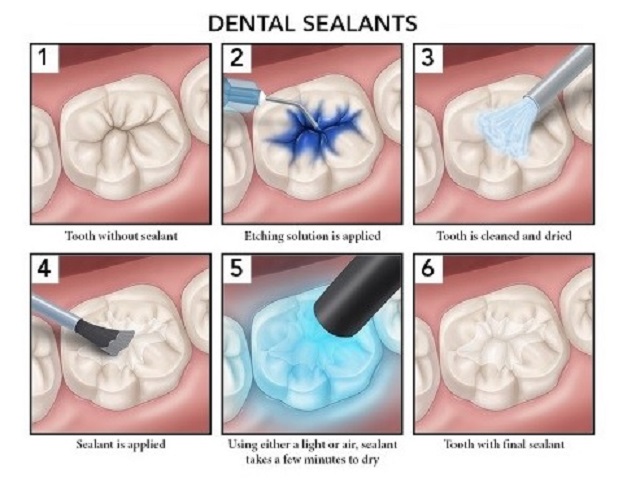
Dental sealants are plastic coatings that are usually placed on the chewing (occlusal) surface of the permanent back teeth — the molars and premolars — to help protect them from decay.
Why are dental sealants placed on teeth?
The chewing surfaces of the molar and premolar teeth have grooves — “fissures” — that make them vulnerable to decay. These fissures can be deep, are difficult to clean, and can be narrower than even a single bristle of a toothbrush. Plaqueaccumulates in these areas, and the acid from bacteria in the plaque attacks the enamel and cavities can develop. Fluoride helps prevent decay and helps protect all the surfaces of the teeth, dental sealants provide extra protection for the grooved and pitted areas by providing a smooth surface covering over the fissured area.
When are dental sealants placed?
The first dental sealant to be placed is usually on the fissure of the first permanent molar tooth, once the chewing surface of the tooth has erupted completely beyond the gum. This tooth grows in behind the baby teeth. If the chewing (occlusal) surfaces of these teeth are sealed, the dental sealant will help protect the tooth. Except for the wisdom teeth, which come through much later, the molars and premolars continue to erupt until eleven-thirteen years of age and the chewing surfaces of these teeth can be sealed after they have erupted beyond the gum.
Are dental sealants only placed on the chewing surface of molar and premolar permanent teeth?
Dental sealants are usually placed on the chewing surfaces of these teeth because these are the areas and teeth that typically have deep fissures. Dental sealants are sometimes also used on other permanent teeth if they have grooves or pits, to help protect these surfaces. In some children, the molars in the primary dentition (baby teeth) also have grooves that could benefit from dental sealants and in this situation your dentist or hygienist may recommend dental sealants on the chewing surfaces of these primary teeth.
Can dental sealants be place on the teeth of adults?
Yes — while less common, dental sealants are sometimes placed in adults at risk for caries, on deep grooves and fissures that do not already have fillings or dental sealants.
What do dental sealants look like?
Dental sealants can be clear, white or have a slight tint depending upon the dental sealant used.

